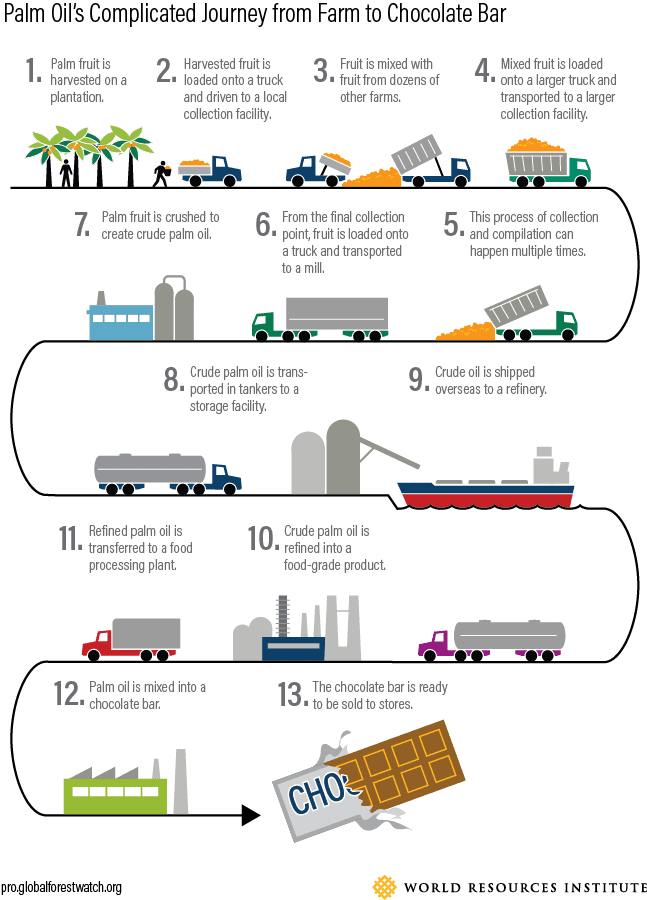Imagine you are a sustainability officer for a candy company that uses palm oil in its chocolate bars. How do you determine if the oil you are buying has contributed to deforestation?
It’s a common quandary: More than 360 companies have committed to eliminating deforestation from their supply chains by 2020. Most will miss this target. The complexity of agricultural supply chains—which contain a labyrinth of intermediaries between farm and final product—makes achieving this goal exceedingly difficult.
Take palm oil: The journey usually begins on a small-scale plantation where fruit is harvested and driven to a local collection facility. These facilities can source from dozens of farms in the area, mixing the harvests together into one heap. From there, the chain of transportation quickly becomes muddled as the fruit travels in increasingly larger piles to bigger and bigger collection facilities.
The palm fruit then goes to a mill to be pressed into crude palm oil, where it’s combined with hundreds of tons of other palm fruits from hundreds of farms, every day. The palm oil is then shipped to a refinery, mixed with other shipments, and finally, sold to the candy company that will use it in chocolate bars. And this long and complex chain is typical for nearly all commodities, from cocoa to soy to beef.
If you were that sustainability officer, where would you start?

GFW Pro Can Analyze Commodities’ Deforestation Trends
A new tool can help. Global Forest Watch (GFW) Pro helps detect deforestation in your supply chain or investment portfolio and then do something about it, whether you’re a small palm oil trader in Indonesia, an agricultural investment bank in Paraguay, or a major global brand like Walmart. Users can securely upload thousands of datapoints representing their supply or investments— whether they’re highly specific shape file outlines of a farm or simple point locations for collection facilities. From there, users can view data on recent and historic deforestation in their supply area, active fires, protected areas and more. Users can also analyze risk across their entire global supply chain or investment portfolio to determine where company operations are posing the biggest threat to forests, and monitor whether corporate sustainability strategies are working. No other monitoring tools have ever accomplished these feats with such openness and global scale— an example of the power of a strong partnership between researchers, tech providers, donors and private sector representatives.
GFW Pro is intended to create a supply chain of trustworthy data by targeting the needs of corporations at the center of the supply chain—manufacturers, commodity traders, and bankers who are buying from or financing farms, mills, processing facilities and slaughterhouses. These companies can prioritize monitoring and data collection in their direct supply, creating pressure and incentives for better monitoring and reporting by collection facilities, and eventually even individual farms. Additionally, GFW Pro can help this information move up the supply chain towards retailers. With accurate and consistent information, actors at all supply chain levels can better address deforestation.
Any organization can get a GFW Pro account, and once data has been uploaded into the system, the resource-intensive manual task of repeatedly monitoring geospatial data can now be done quickly and cheaply by companies of all sizes. The tool works for any commodity, anywhere—from soy in Brazil to rubber in Thailand. There is now no excuse not to monitor.
Who Is Using GFW Pro?
The platform was designed with input from leading commodity companies and financial institutions to ensure that the features align with businesses’ daily operations and needs. Seventy organizations piloted GFW Pro since October. For example:
- IDB Invest, the arm of the Inter-American Development Bank (IDB) investing in the private sector, is using GFW Pro to monitor clients’ investments. The bank moved to GFW Pro from a document-based monitoring system and saw a night-to-day improvement in its operations. IDB’s clients, local banks operating in Latin America, can now instantly reference information that was previously inaccessible— allowing them to determine if a farm is in good legal standing or potentially located in a protected or otherwise prohibited area.
- Olam, a leading agri-business, mapped more than 1,000 palm, cocoa, timber and rubber facilities. Using GFW Pro, the company was able to determine that nearly half their palm supply was at risk of causing deforestation. Olam now reviews the risk of all its palm oil locations on a monthly basis.
- Cargill mapped and assessed more than 188,000 hectares of forest within its direct cocoa supply chain. This helps establish a baseline of where the company’s cocoa is coming from, and how much might be at risk of causing deforestation.
Using GFW Pro to Root Deforestation Out of Supply Chains
Studies estimate that commodities drive nearly 40 percent of tropical deforestation, which means that companies have tremendous influence over the world’s forests and the power to make a difference. GFW Pro can help them make good on their promises to eliminate deforestation from their supply chains, achieving dual outcomes of protecting forests and avoiding risks that deforestation poses to their business. With effective forest and supply chain monitoring, companies can now demonstrate their progress publicly in quantitative and credible terms.
While GFW Pro encourages geospatial monitoring for deforestation, it also serves as a catalyst for a larger private sector movement towards technology use for better land management. It is a first step in applying similar strategies to other global sustainable agriculture challenges.








